Spatial Distribution of the Micro-Mechanical Properties in High-Translucent CAD/CAM Resin-Composite Blocks
Abstract
1. Introduction
2. Materials and Methods
2.1. Specimen Preparation
2.2. Depth-Sensing Indentation Parameters
2.3. Scanning Electron Microscopy (SEM)
2.4. Statistical Analyses
3. Results
4. Discussion
5. Conclusions
Funding
Acknowledgments
Conflicts of Interest
References
- Broadbent, J.M.; Murray, C.M.; Schwass, D.R.; Brosnan, M.; Brunton, P.A.; Lyons, K.S.; Thomson, W.M. The Dental Amalgam Phasedown in New Zealand: A 20-year Trend. Oper. Dent. 2020, 45, 255–264. [Google Scholar] [CrossRef] [PubMed]
- Miyagawa, Y.; Powers, J.M.; O’Brien, W.J. Optical properties of direct restorative materials. J. Dent. Res. 1981, 60, 890–894. [Google Scholar] [CrossRef] [PubMed]
- Lee, Y.K. Criteria for clinical translucency evaluation of direct esthetic restorative materials. Restor. Dent. Endod. 2016, 41, 159–166. [Google Scholar] [CrossRef] [PubMed]
- Ilie, N.; Furtos, G. A Comparative Study of Light Transmission by Various Dental Restorative Materials and the Tooth Structure. Oper. Dent. 2020. [Google Scholar] [CrossRef]
- Ilie, N.; Hickel, R. Investigations on mechanical behaviour of dental composites. Clin. Oral Investig. 2009, 13, 427–438. [Google Scholar] [CrossRef] [PubMed]
- Ilie, N.; Stark, K. Curing behaviour of high-viscosity bulk-fill composites. J. Dent. 2014, 42, 977–985. [Google Scholar] [CrossRef]
- Shortall, A.; El-Mahy, W.; Stewardson, D.; Addison, O.; Palin, W. Initial fracture resistance and curing temperature rise of ten contemporary resin-based composites with increasing radiant exposure. J. Dent. 2013, 41, 455–463. [Google Scholar] [CrossRef]
- Ilie, N.; Watts, D.C. Outcomes of ultra-fast (3 s) photo-cure in a RAFT-modified resin-composite. Dent. Mater. 2020, 36, 570–579. [Google Scholar] [CrossRef]
- Ferracane, J.L. Resin composite—state of the art. Dent. Mater. 2011, 27, 29–38. [Google Scholar] [CrossRef]
- Ferracane, J.L. Resin-based composite performance: Are there some things we can’t predict? Dent. Mater. 2013, 29, 51–58. [Google Scholar] [CrossRef]
- Pallesen, U.; van Dijken, J.W. A randomized controlled 30 years follow up of three conventional resin composites in Class II restorations. Dent. Mater. 2015, 31, 1232–1244. [Google Scholar] [CrossRef] [PubMed]
- Opdam, N.J.; Bronkhorst, E.M.; Loomans, B.A.; Huysmans, M.C. 12-year survival of composite vs. amalgam restorations. J. Dent. Res. 2010, 89, 1063–1067. [Google Scholar] [CrossRef] [PubMed]
- Rasines Alcaraz, M.G.; Veitz-Keenan, A.; Sahrmann, P.; Schmidlin, P.R.; Davis, D.; Iheozor-Ejiofor, Z. Direct composite resin fillings versus amalgam fillings for permanent or adult posterior teeth. Cochrane Database Syst. Rev. 2014. [Google Scholar] [CrossRef] [PubMed]
- Alvanforoush, N.; Palamara, J.; Wong, R.; Burrow, M.F. A Comparison between published clinical success of direct resin composite restorations in vital posterior teeth in 1995–2005 and 2006–2016 periods. Aust. Dent. J. 2016, 62, 132–145. [Google Scholar] [CrossRef] [PubMed]
- Ilie, N. Altering of optical and mechanical properties in high-translucent CAD-CAM resin composites during aging. J. Dent. 2019, 85, 64–72. [Google Scholar] [CrossRef] [PubMed]
- Hussain, B.; Thieu, M.K.L.; Johnsen, G.F.; Reseland, J.E.; Haugen, H.J. Can CAD/CAM resin blocks be considered as substitute for conventional resins? Dent. Mater. 2017, 33, 1362–1370. [Google Scholar] [CrossRef]
- Suh, B.I. New concepts and technology for processing of indirect composites. Compend. Contin. Educ. Dent. (Jamesburg, N.J.: 1995) 2003, 24, 40–42. [Google Scholar]
- Ruse, N.D.; Sadoun, M.J. Resin-composite blocks for dental CAD/CAM applications. J. Dent. Res. 2014, 93, 1232–1234. [Google Scholar] [CrossRef]
- Ionescu, A.C.; Hahnel, S.; Konig, A.; Brambilla, E. Resin composite blocks for dental CAD/CAM applications reduce biofilm formation in vitro. Dent. Mater. 2020, 36, 603–616. [Google Scholar] [CrossRef]
- DIN-50359-1. Testing of Metallic Materials—Universal Hardness Test—Part 1: Test Method; German Institute for Standardisation: Berlin, Germany, 1997. [Google Scholar]
- Oliver, W.C.; Pharr, G.M. Depth-Sensing Indentation Testing. In Introduction to Contact Mechanics; Mechanical Engineering Series; Springer: Boston, MA, USA, 2007. [Google Scholar]
- ISO/DIS. 14577-5 Metallic materials—Instrumented indentation test for hardness and materials parameters. In Part 5: Linear Elastic Dynamic Instrumented Indentation Testing (DIIT); ISO: Geneva, Switzerland, 2015. [Google Scholar]
- Stansbury, J.W. Dimethacrylate network formation and polymer property evolution as determined by the selection of monomers and curing conditions. Dent. Mater. 2012, 28, 13–22. [Google Scholar] [CrossRef]
- Barszczewska-Rybarek, I.M. Structure–property relationships in dimethacrylate networks based on Bis-GMA, UDMA and TEGDMA. Dent. Mater. 2009, 25, 1082–1089. [Google Scholar] [CrossRef] [PubMed]
- Rey, L.; Duchet, J.; Galy, J.; Sautereau, H.; Vouagner, D.; Carrion, L. Structural heterogeneities and mechanical properties of vinyl/dimethacrylate networks synthesized by thermal free radical polymerization. Polymer 2002, 43, 4375–4384. [Google Scholar] [CrossRef]
- Johnson, K.L. Contact Mechanics; Cambridge University Press: Cambridge, UK, 1985. [Google Scholar] [CrossRef]
- Braem, M.; Lambrechts, P.; Van Doren, V.; Vanherle, G. The impact of composite structure on its elastic response. J. Dent. Res. 1986, 65, 648–653. [Google Scholar] [CrossRef] [PubMed]
- Grajower, R.; Wozniak, W.T.; Lindsay, J.M. Optical properties of composite resins. J. Oral Rehabil. 1982, 9, 389–399. [Google Scholar] [CrossRef] [PubMed]
- Palin, W.M.; Leprince, J.G.; Hadis, M.A. Shining a light on high volume photocurable materials. Dent. Mater. 2018, 34, 695–710. [Google Scholar] [CrossRef]
- Shortall, A.C.; Palin, W.M.; Burtscher, P. Refractive index mismatch and monomer reactivity influence composite curing depth. J. Dent. Res. 2008, 87, 84–88. [Google Scholar] [CrossRef] [PubMed]
- Goldberg, M.; Kulkarni, A.B.; Young, M.; Boskey, A. Dentin: Structure, composition and mineralization. Front. Biosci. 2011, 3, 711–735. [Google Scholar] [CrossRef]
- Ashby, M.F. The CES EduPack Database of Natural and Man-Made Materials; Cambridge University and Granta Design: Cambridge, UK, 2008. [Google Scholar]
- Webster, G.A. Role of Residual Stress in Engineering Applications. Mater. Sci. Forum 2000, 347, 1–11. [Google Scholar] [CrossRef]
- Ligon, S.C.; Husár, B.; Wutzel, H.; Holman, R.; Liska, R. Strategies to Reduce Oxygen Inhibition in Photoinduced Polymerization. Chem. Rev. 2014, 114, 557–589. [Google Scholar] [CrossRef]
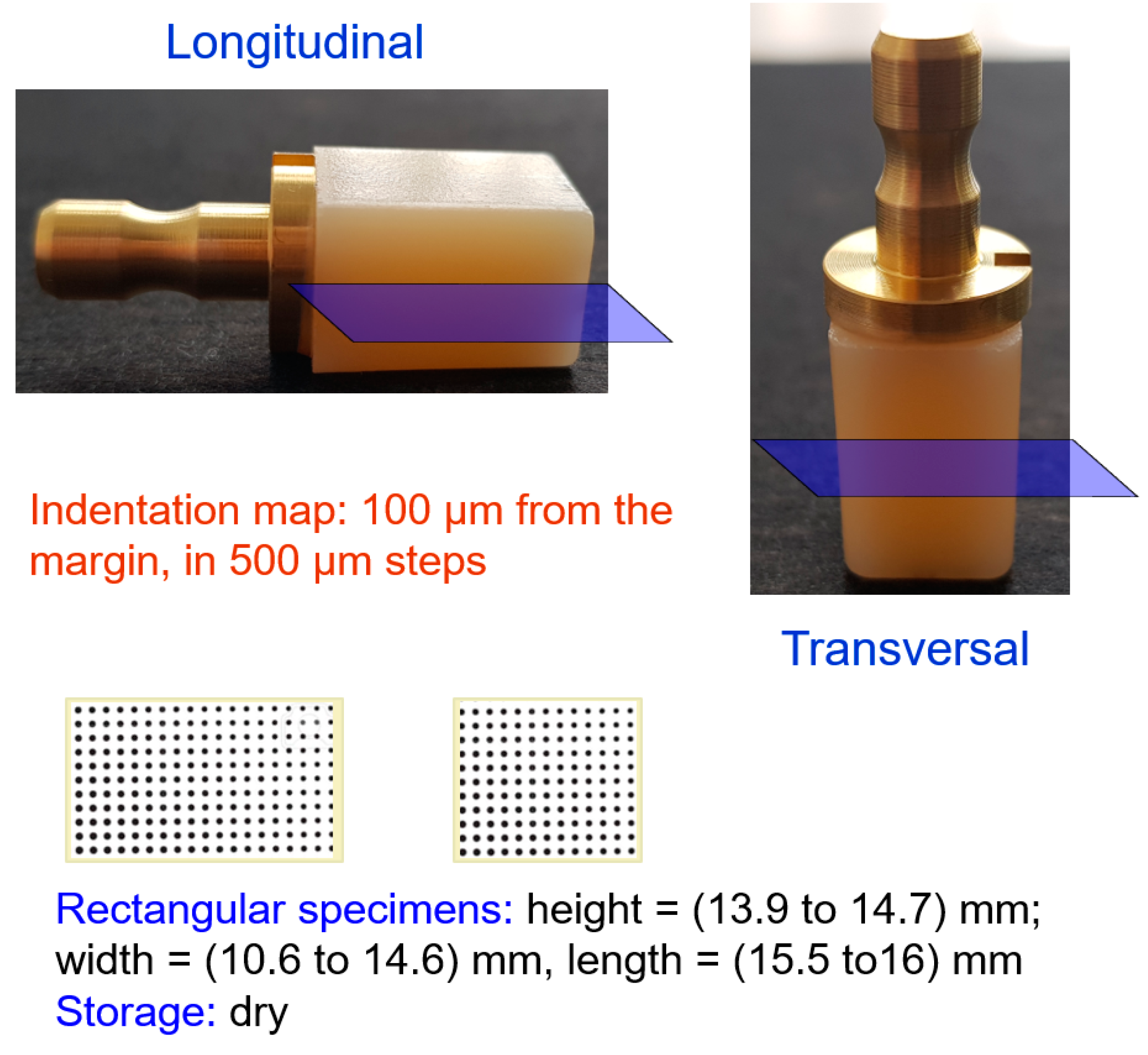
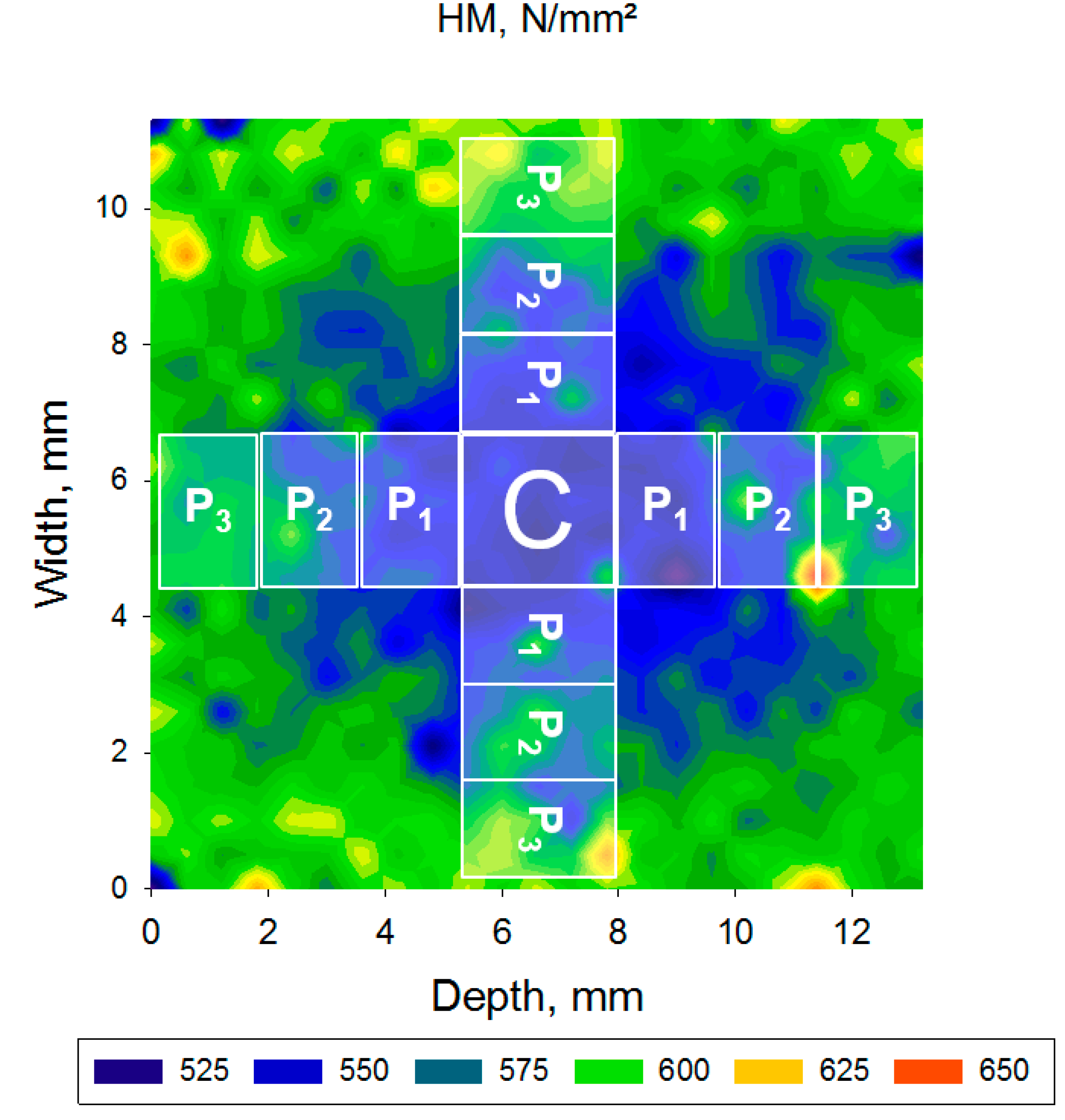
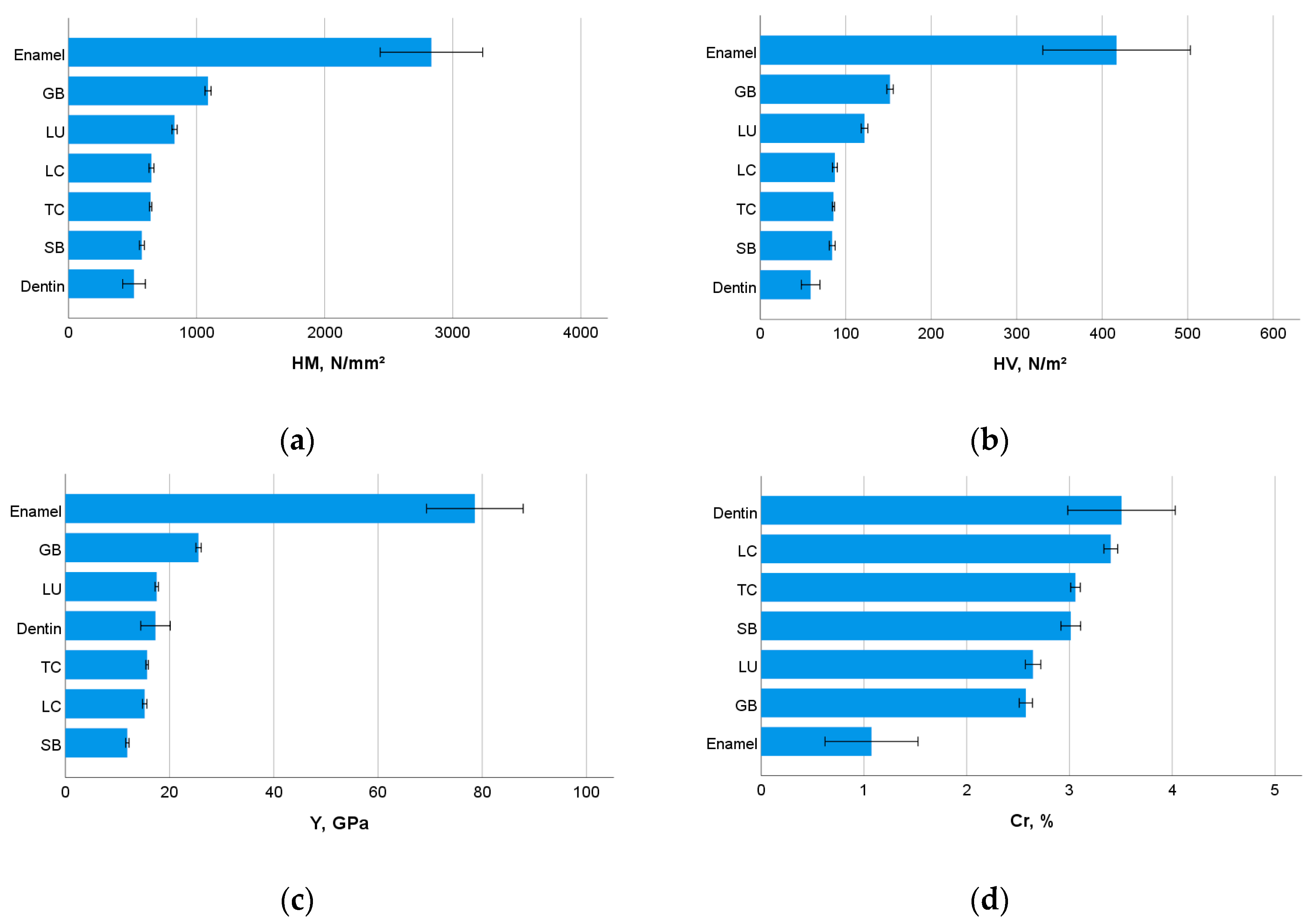


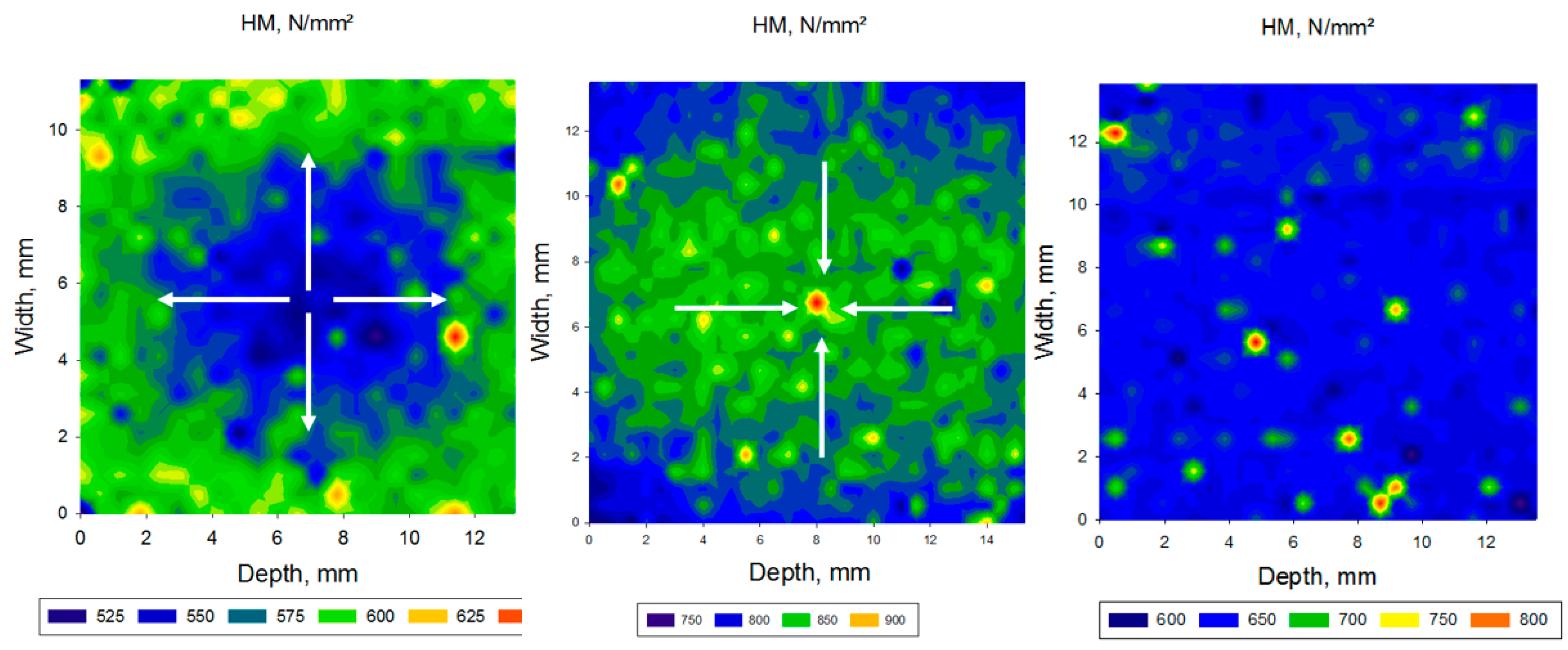
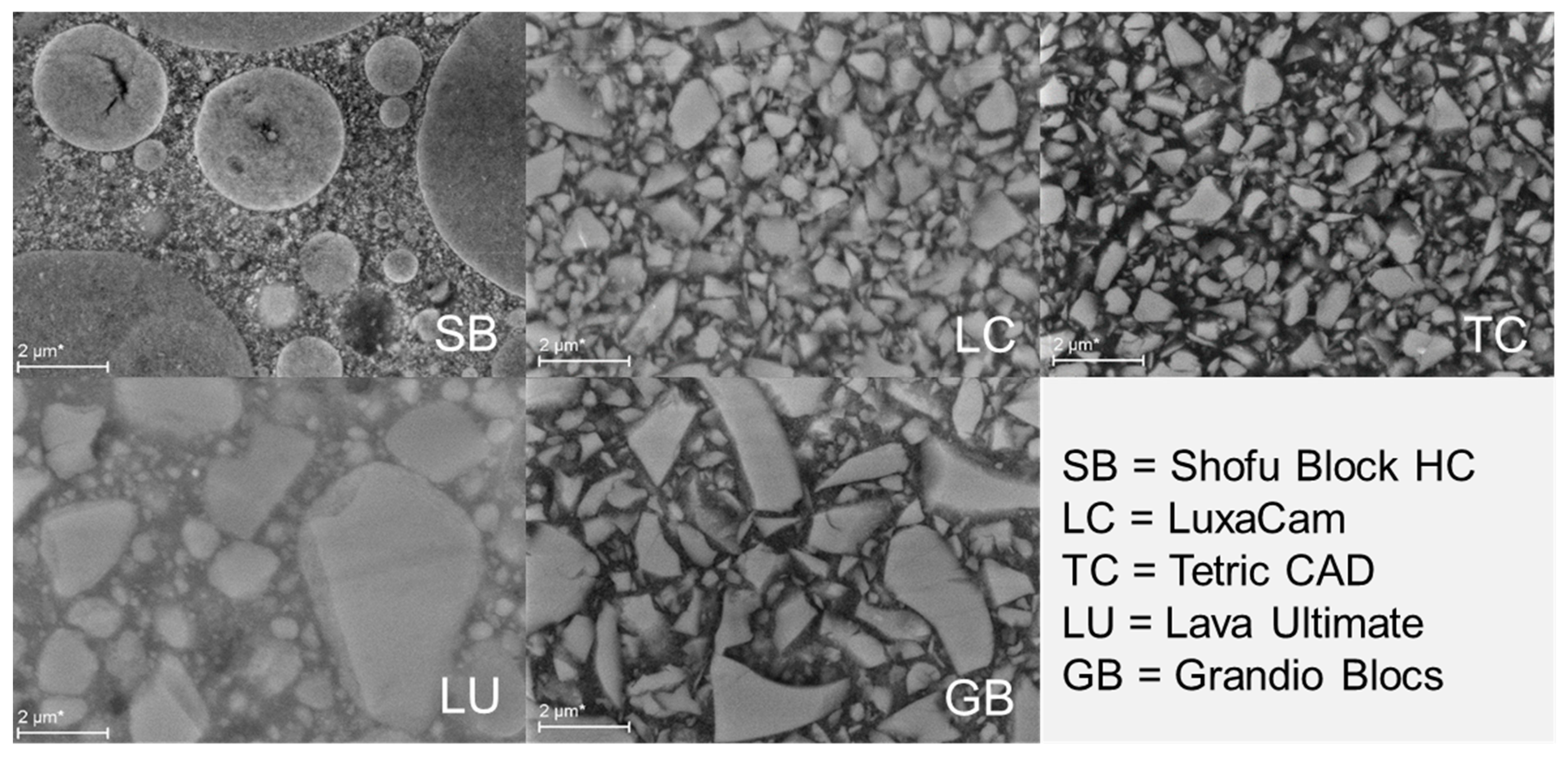
| Code | CAD/CAM RBC | Manufacturer | Shade | LOT | Monomer | Filler | |
|---|---|---|---|---|---|---|---|
| Composition | wt.% | ||||||
| SB | Shofu Block HC | Shofu | A3 HT | 071601 | UDMA TEGDMA | SiO2, silicate, zirconium silicate | 61 |
| LC | Luxacam Composite | DMG | A3 | 769515 | Methacrylates | SiO2-glass | 70 |
| TC | Tetric CAD | Ivoclar Vivadent | A3 HT | W93631 | Bis-GMA UDMA Bis-EMA TEGDMA | BaO-Al2O3-SiO2-glass, SiO2 | 71.1 |
| LU | Lava Ultimate | 3M | A3 HT | N933699 | Bis-GMA UDMA Bis-EMA TEGDMA | SiO2, ZrO2, aggregated ZrO2/SiO2 cluster | 80 |
| GB | Grandio Blocs | Voco | A3 HT | 1709591 | Methacrylates | n.a. | 86 |
| CAD/CAM RBC | HM [N/m²] | HV [N/m²] | Y [GPa] | Cr [%] | We [µJ] | Wtot [µJ] | Filler [wt.%] |
|---|---|---|---|---|---|---|---|
| SB | 573.2 A | 84.2 A | 11.9 A | 3.01 C | 0.57 E | 0.99 E | 61 |
| 19.1 | 3.4 | 0.3 | 0.10 | 0.01 | 0.02 | ||
| TC | 641.3 B | 85.7 B | 15.7 C | 3.06 D | 0.45 B | 0.93 D | 71.1 |
| 9.2 | 1.3 | 0.2 | 0.05 | 0.00 | 0.00 | ||
| LC | 647.7 C | 87.3 C | 15.2 B | 3.40 E | 0.47 D | 0.93 C | 70 |
| 19.3 | 2.9 | 0.4 | 0.07 | 0.01 | 0.01 | ||
| LU | 828.0 D | 122.0 D | 17.5 D | 2.65 B | 0.45 C | 0.82 B | 80 |
| 20.2 | 3.9 | 0.3 | 0.07 | 0.00 | 0.01 | ||
| GB | 1089.4 E | 151.9 E | 25.6 E | 2.58 A | 0.35 A | 0.72 A | 86 |
| 23.7 | 3.8 | 0.5 | 0.06 | 0.00 | 0.01 |
| SB | HM | HV | Y | Cr | We | Wtot | ||||||
|---|---|---|---|---|---|---|---|---|---|---|---|---|
| T | L | T | L | T | L | T | L | T | L | T | L | |
| C | 549.3 a | 549.4 a | 79.7 a | 79.5 a | 11.6 a | 11.6 a | 3.13 a | 3.17 | 0.57 a | 0.57 a | 1.01 a | 1.01 a |
| 12.4 | 9.7 | 2.1 | 1.6 | 0.2 | 0.2 | 0.06 | 0.05 | 0.01 | 0.01 | 0.01 | 0.01 | |
| P1 | 560.5 b | 552.5 a | 81.7 b | 80.2 a | 11.7 b | 11.6 a | 3.07 b | 3.15 | 0.57 ab | 0.57 a | 1.00 b | 1.01 a |
| 14.8 | 11.7 | 2.5 | 2.1 | 0.2 | 0.2 | 0.06 | 0.06 | 0.01 | 0.01 | 0.01 | 0.01 | |
| P2 | 580.1 c | 568.6 b | 85.3 c | 83.5 b | 12.0 c | 11.8 b | 3.00 c | 3.03 | 0.56 b | 0.57 b | 0.98 c | 0.99 a |
| 15.7 | 17.0 | 2.8 | 3.0 | 0.2 | 0.3 | 0.07 | 0.08 | 0.01 | 0.01 | 0.01 | 0.01 | |
| P3 | 589.9 d | 573.0 bc | 87.3 d | 84.4 bc | 12.2 d | 11.9 b | 2.94 d | 2.99 | 0.56 b | 0.57 c | 0.97 d | 0.99 a |
| 16.1 | 15.4 | 3.1 | 2.7 | 0.2 | 0.3 | 0.08 | 0.09 | 0.01 | 0.01 | 0.02 | 0.01 | |
| P4 | 577.2 c | 85.2 c | 11.9 b | 2.97 | 0.57 c | 0.98 a | ||||||
| 19.3 | 3.1 | 0.3 | 0.08 | 0.01 | 0.02 | |||||||
| TC | HM | HV | Y | Cr | We | Wtot | ||||||
|---|---|---|---|---|---|---|---|---|---|---|---|---|
| T | L | T | L | T | L | T | L | T | L | T | L | |
| C | 646.6 a | 643.5 a | 86.5 a | 85.8 a | 15.8 a | 15.8 a | 3.06 a | 3.06 a | 0.45 a | 0.45 a | 0.93 a | 0.93 a |
| 6.3 | 5.8 | 0.9 | 0.7 | 0.1 | 0.2 | 0.02 | 0.03 | 0.00 | 0.00 | 0.00 | 0.00 | |
| P1 | 646.8 a | 638.6 b | 86.6 a | 85.4 a | 15.8 ab | 15.6 a | 3.06 ab | 3.06 ab | 0.45 a | 0.45 a | 0.93 ab | 0.93 a |
| 8.0 | 5.0 | 1.3 | 0.6 | 0.1 | 0.2 | 0.04 | 0.03 | 0.00 | 0.00 | 0.00 | 0.00 | |
| P2 | 643.0 ab | 640.3 b | 85.9 ab | 85.5 a | 15.7 ab | 15.7 a | 3.07 ab | 3.07 ab | 0.45 a | 0.45 a | 0.93 ab | 0.93 a |
| 15.1 | 6.0 | 2.2 | 0.8 | 0.3 | 0.2 | 0.06 | 0.04 | 0.00 | 0.01 | 0.01 | 0.00 | |
| P3 | 639.5 b | 641.0 b | 85.4 b | 85.5 a | 15.7 b | 15.7 a | 3.08 b | 3.07 ab | 0.45 a | 0.45 a | 0.93 b | 0.93 a |
| 10.0 | 7.1 | 1.4 | 1.0 | 0.3 | 0.2 | 0.04 | 0.05 | 0.01 | 0.00 | 0.01 | 0.00 | |
| P4 | 639.6 b | 85.6 a | 15.6 a | 3.08 b | 0.45 a | 0.93 a | ||||||
| 6.5 | 1.0 | 0.2 | 0.05 | 0.01 | 0.00 | |||||||
| LC | HM | HV | Y | Cr | We | Wtot | ||||||
|---|---|---|---|---|---|---|---|---|---|---|---|---|
| T | L | T | L | T | L | T | L | T | L | T | L | |
| C | 643.4 a | 658.4 a | 86.8 a | 88.7 a | 15.1 a | 15.5 a | 3.40 a | 3.38 a | 0.47 a | 0.46 a | 0.93 a | 0.92 a |
| 8.8 | 8.1 | 1.3 | 1.2 | 0.2 | 0.3 | 0.04 | 0.04 | 0.00 | 0.00 | 0.01 | 0.01 | |
| P1 | 644.6 a | 658.3 a | 87.1 a | 88.8 a | 15.1 a | 15.5 a | 3.40 ab | 3.38 ab | 0.47 a | 0.46 a | 0.93 a | 0.92 a |
| 9.4 | 12.6 | 1.4 | 2.0 | 0.2 | 0.3 | 0.04 | 0.04 | 0.00 | 0.00 | 0.01 | 0.01 | |
| P2 | 644.2 a | 654.3 ab | 87.0 a | 88.2 ab | 15.1 a | 15.4 ab | 3.41 ab | 3.39 ab | 0.47 a | 0.46 a | 0.93 a | 0.92 a |
| 13.5 | 16.9 | 2.0 | 2.6 | 0.3 | 0.4 | 0.05 | 0.06 | 0.01 | 0.01 | 0.01 | 0.01 | |
| P3 | 646.8 a | 648.2 bc | 87.2 a | 87.2 bc | 15.1 a | 15.3 bc | 3.40 ab | 3.40 ab | 0.47 a | 0.46 a | 0.93 a | 0.92 a |
| 16.7 | 15.7 | 2.5 | 2.3 | 0.4 | 0.4 | 0.06 | 0.06 | 0.01 | 0.01 | 0.01 | 0.01 | |
| P4 | 642.4 a | 643.8 c | 86.8 a | 86.7 c | 15.0 a | 15.1 c | 3.43 b | 3.41 b | 0.47 a | 0.47 b | 0.93 a | 0.93 b |
| 18.8 | 29.1 | 2.8 | 4.3 | 0.4 | 0.5 | 0.07 | 0.11 | 0.01 | 0.01 | 0.01 | 0.01 | |
| LU | HM | HV | Y | Cr | We | Wtot | ||||||
|---|---|---|---|---|---|---|---|---|---|---|---|---|
| T | L | T | L | T | L | T | L | T | L | T | L | |
| C | 836.1 a | 843.1 a | 124.2 a | 124.5 a | 17.5 a | 17.9 a | 2.6 a | 2.59 a | 0.45 a | 0.45 a | 0.82 a | 0.82 a |
| 16.7 | 21.6 | 3.5 | 4.3 | 0.2 | 0.3 | 0.05 | 0.05 | 0.00 | 0.00 | 0.01 | 0.01 | |
| P1 | 833.7 a | 839.1 ab | 123.9 a | 123.8 ab | 17.5 a | 17.8 a | 2.61 a | 2.62 a | 0.45 ab | 0.45 a | 0.82 a | 0.82 ab |
| 13.0 | 9.7 | 2.6 | 1.9 | 0.2 | 0.1 | 0.05 | 0.06 | 0.00 | 0.00 | 0.01 | 0.01 | |
| P2 | 831.3 ab | 833.6 bc | 123.3 a | 122.7 bc | 17.5 a | 17.7 ab | 2.64 a | 2.62 ab | 0.45 ab | 0.45 a | 0.82 ab | 0.82 ab |
| 15.8 | 15.5 | 3.3 | 2.8 | 0.2 | 0.3 | 0.06 | 0.07 | 0.001 | 0.001 | 0.01 | 0.01 | |
| P3 | 824.7 b | 826.8 c | 121.8 b | 121.5 c | 17.4 a | 17.6 b | 2.67 b | 2.65 b | 0.45 b | 0.45 a | 0.83 b | 0.82 b |
| 21.2 | 24.4 | 4.0 | 4.9 | 0.3 | 0.3 | 0.08 | 0.07 | 0.00 | 0.00 | 0.01 | 0.01 | |
| P4 | - | 815.0 d | - | 119.2 d | - | 17.4 c | - | 2.69 c | - | 0.45 a | - | 0.83 c |
| 19.9 | 3.5 | 0.4 | 0.08 | 0.001 | 0.01 | |||||||
| GB | HM | HV | Y | Cr | We | Wtot | ||||||
|---|---|---|---|---|---|---|---|---|---|---|---|---|
| T | L | T | L | T | L | T | L | T | L | T | L | |
| C | 1108.0 a | 1088.4 a | 154.9 a | 151.6 a | 25.9 a | 25.6 a | 2.54 a | 2.61 a | 0.35 a | 0.35 a | 0.71 a | 0.72 a |
| 13.7 | 12.3 | 2.4 | 2.4 | 0.2 | 0.2 | 0.05 | 0.03 | 0.00 | 0.00 | 0.01 | 0.01 | |
| P1 | 1106.1 a | 1090.6 ab | 154.6 a | 151.7 a | 25.9 a | 25.6 a | 2.56 a | 2.63 a | 0.35 a | 0.35 a | 0.71 a | 0.72 a |
| 10.0 | 13.2 | 1.9 | 2.4 | 0.3 | 0.2 | 0.05 | 0.05 | 0.00 | 0.00 | 0.01 | 0.01 | |
| P2 | 1101.8 ab | 1083.0 abc | 154.0 ab | 150.8 ab | 25.8 ab | 25.5 ab | 2.56 a | 2.59 b | 0.35 a | 0.35 a | 0.71 a | 0.72 ab |
| 17.8 | 15.0 | 2.9 | 2.4 | 0.4 | 0.4 | 0.05 | 0.05 | 0.00 | 0.00 | 0.01 | 0.01 | |
| P3 | 1095.2 b | 1078.9 bc | 152.9 bc | 150.4 ab | 25.7 ab | 25.3 bc | 2.56 a | 2.59 b | 0.35 a | 0.35 a | 0.72 a | 0.72 b |
| 18.8 | 17.2 | 2.9 | 2.8 | 0.5 | 0.4 | 0.05 | 0.05 | 0.00 | 0.00 | 0.01 | 0.01 | |
| P4 | 1095.7 b | 1075.1 c | 152.7 c | 149.8 b | 25.8 b | 25.2 c | 2.56 a | 2.59 b | 0.35 b | 0.35 a | 0.72 a | 0.72 b |
| 19.2 | 40.3 | 3.1 | 6.4 | 0.5 | 0.7 | 0.08 | 0.08 | 0.01 | 0.00 | 0.01 | 0.01 | |
© 2020 by the author. Licensee MDPI, Basel, Switzerland. This article is an open access article distributed under the terms and conditions of the Creative Commons Attribution (CC BY) license (http://creativecommons.org/licenses/by/4.0/).
Share and Cite
Ilie, N. Spatial Distribution of the Micro-Mechanical Properties in High-Translucent CAD/CAM Resin-Composite Blocks. Materials 2020, 13, 3352. https://doi.org/10.3390/ma13153352
Ilie N. Spatial Distribution of the Micro-Mechanical Properties in High-Translucent CAD/CAM Resin-Composite Blocks. Materials. 2020; 13(15):3352. https://doi.org/10.3390/ma13153352
Chicago/Turabian StyleIlie, Nicoleta. 2020. "Spatial Distribution of the Micro-Mechanical Properties in High-Translucent CAD/CAM Resin-Composite Blocks" Materials 13, no. 15: 3352. https://doi.org/10.3390/ma13153352
APA StyleIlie, N. (2020). Spatial Distribution of the Micro-Mechanical Properties in High-Translucent CAD/CAM Resin-Composite Blocks. Materials, 13(15), 3352. https://doi.org/10.3390/ma13153352




